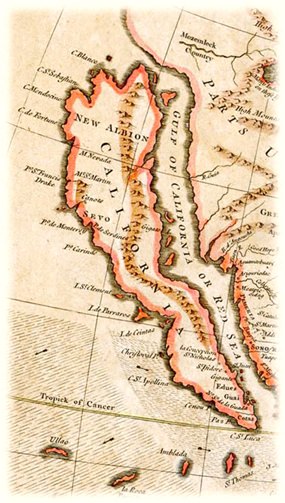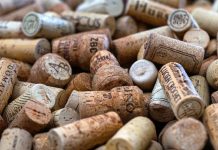When Hernán Cortés and his group of weary seafarers made landfall on 3rd May 1535 on what is now known as Baja California, he was pretty sure that they were on an island. Perhaps Cortés thought that he’d stumbled upon the mythical Island of California, described in a well-known Spanish novel by Garcia Ordonez de Montalvo. It was entitled The Adventures of Esplandián and first printed, as far as we know in 1510. The author described a fictitious island which he named California, ruled by one Queen Calafia and her entourage of large and ferocious warrior-women. Despite this alarming prospect, or perhaps because of it, the myth evidently motivated Spanish explorers to find this exotic land.
Cortés established the ill-fated settlement of Santa Cruz, but no one knows how or why a fictitious name in a novel became the name of an actual place. The settlement didn’t survive for long, largely because the native Indians were understandably a bit miffed at the unwelcome intrusion. Within months many of the settlers had died of starvation or been killed off by the locals, and eventually the colony was abandoned. But the island myth prevailed and further expeditions seemed unable to prove conclusively the exact nature of the region. For years afterwards, many maritime charts perpetuated the island theory and it wasn’t until 1747 that the matter was settled by King Ferdinand VI of Spain. He issued a royal proclamation announcing that California was not an island after all.
 A 1745 map of California, by R. W. Seale
A 1745 map of California, by R. W. Seale
At about this time much further north, Franciscan monks started making the first Californian wine. (I was wondering when we’d finally get there – Ed.) It was probably nothing more than rustic plonk but by the 1850s Californian wines were vastly improved. In the closing years of the 19th century the state was producing more than two million gallons every year.
Beringer (pronounced these days with a soft “g”) is an old-established company which, as the name implies, has German roots. In 1868 Jacob Beringer travelled from Germany to New York and eventually made his way to California. He and his brother bought a couple of hundred acres of land and started one of the first wineries in Napa Valley.
Beringer Founders’ Estate Chardonnay 2012 (white), California USA (Bt. 835 @ Q-Wine)
The Founders’ Estate range consists of twelve wines, mostly varietals which have been designed for easy enjoyment. This is a lovely bright, greenish-gold wine with that attractive oily appearance that you sometimes find in high-alcohol wines. This one comes at a rather high 13.8% ABV (alcohol by volume) although it took me ages to find out. I eventually discovered with the aid of my grandmother’s magnifying glass and it’s shown in minuscule print on the side of the label. When you come to think about it, 13.8% is strangely precise value. European wine labels show their ABV to the nearest whole or half percentage. In the USA however, higher taxes are levied on wines above 14% ABV, so perhaps this is the reason. Even so, American wineries are allowed a 1.5% leeway in their stated ABV so it might actually be even higher.
The aroma is typical New World Chardonnay though richer than usual and with the distinct smell of pear drops. The tropical fruits are out in force, especially pineapple along with pear, apple, citrus and honeyed vanilla. I thought there might be a tingle of fresh herbs too. The mouth-feel is rich and unctuous with plenty of fruit and vanilla and there’s a satisfying balance of fruit and acidity with a lingering, dry finish. It’s a few degrees away from being completely dry and the fruit creates an illusion of sweetness. This is no pussy-footing wine – it’s a big-hearted Californian that’s made to please. Try to finish the bottle in one evening, because it tends to fade after a day or so. It’s probably best with food. We tend to think of pairing white wine with fish, but this would overpower many fish dishes. Try it with grilled salmon, roast pork or poultry.
Beringer Founders’ Estate Merlot 2011 (red), California USA (Bt. 835 @ Q-Wine)
This is a very approachable wine; dark purple-red with thick syrupy legs, usually a sign of fairly high alcohol content, in this case 13.5% ABV. There’s a rich fruity aroma of blackberries and plums with a dash of spiciness and white pepper. You might notice a slightly sharp tang on the aroma at first, but this will probably drift away once the wine has had air contact for fifteen minutes or so. The wine is medium bodied and several degrees away from complete dryness with a very smooth mouth-feel and plenty of blackberry fruit on the palate. You might even notice a slight oaky character because half of the wine was aged in seasoned oak casks. A little bit of Petite Syrah and Syrah were added for complexity and depth of flavour.
The wine has virtually no tannin, at least I couldn’t detect very much. This of course, might come as good news if you are one of those people who don’t much care for tannin on the taste. Needless to say, it’s a wine that’s made for easy enjoyment and would work well with smoked chicken, grilled meats or hearty vegetable dishes.
At the moment these wines are available only at Q-Wine in Bangkok. They have a branch at Major Cineplex on Soi Sukhumvit 61, near to Ekamai and adjacent to Scoozi Italian Restaurant. There’s another Q-Wine branch out of town at The Paseo Shopping Mall at 318 Ladkrabang Road, next door to the local Toyota dealer and not far from Suvarnabhumi Airport.
Incidentally, you may be wondering how Garcia Ordonez de Montalvo got the name California in the first place. Some historians, notably Edward Everett Hale have suggested the word was derived from “caliph” – a person who is leader of an Islamic community. The irony is rich indeed.




